"Everything I've ever done in my life has tried to live up to this." |
| Clerks, Chasing Amy and Red State director Kevin Smith on Buckaroo Banzai |
When we first heard that Arrow were planning to release The Adventures of Buckaroo Banzai Across the 8th Dimension on Blu-ray, neither Camus nor I could contain our excitement. I know this despite the considerable physical distance between us because when I emailed my friend and colleague to inform him of the announcement I got the following response: "I think the multi-syllabled word is FAN-FUCK-ING-TASTIC!" Yes, that just about captures how fond we are of this wonderfully oddball yet gorgeously realised slice of very American genre-bending cinema. Indeed, as a long standing enthusiast for the film, Camus reviewed the US MGM Special Edition DVD back in 2005, not because its release was imminent (it had been available for almost three years at this point) but because he simply wanted to spread the word about a film that back then was rarely discussed outside of cult circles. When this new Blu-ray edition was first announced on Twitter, I had the sinking feeling that little had changed in the subsequent ten years, as while there were excited tweets aplenty about the other simultaneously announced titles, I saw almost none throwing a yahoo in the ring for Buckaroo Banzai. Hats off, then, to those fine people at Arrow who recognise a great cult movie when they see it.
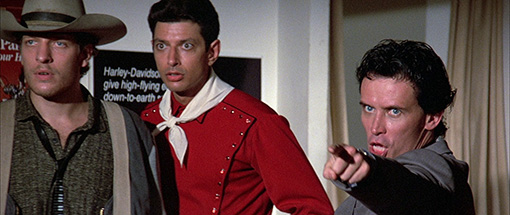
We considered writing a fresh review of the film itself for this release, but as Camus pointed out, he's already said what he wanted to say about the film in his coverage of the DVD. We've thus decided to reproduce that review here, with a few minor tweaks to adjust for that fact that ten years have passed and a different disc is now under examination.
Coming back to the film after a gap of several years, particularly with it looking as great as it does here, I found myself falling in love with it all over again. I'm going to second Camus's comment (which you've not read yet, of course) about a cast whose careers have since blossomed and who would cost a small fortune to assemble today. Indeed, we've since become familiar with even more of the faces here than we were at the time of that original review, a fair few of whom were relative newcomers. John Lithgow had already bagged an Oscar for Terms of Endearment, and Christopher Lloyd had become a comedy favourite through his role as Reverend Jim Ignatowski in the TV series Taxi, but he was still a year away from big screen immortality as Doc Emmett Brown in Back to the Future. It would be another three years before Peter Weller would be immortalised as Officer Alex Murphy in Paul Verhoeven's Robocop, and while Ellen Barkin rarely seemed to find the roles she deserved, she made a serious impression two years on in Jim McBride's The Big Easy and bagged a Primetime Emmy for her role in the 1998 TV Movie Before Women Had Wings. Back then Jeff Goldblum was still playing supporting roles that, according to writer Matt Zoller Seitz, cast him as "almost a walking sight gag," but two years later he proved his worth as a dramatic lead in David Cronenberg's The Fly. Clancy Brown became one of the busiest character actors in the business (to this date he has 234 acting credits on IMDb) and has developed a solid cult following of his own, and I was kicking myself for failing to recognise the late Ronald Lacey as President Widmark, despite having worked with the man and even stayed at his house (he is heavily made up here and his voice has been redubbed, but still...). Dan Hedaya became one of film and TV's more familiar faces (his role as the gruff Nick Tortelli in Cheers was always a personal favourite) and Vincent Schiavelli is a character actor whose distinctive features everyone recognises but whose name almost no-one can ever recall. Scoot down the cast to the smaller roles and you'll find Jonathan Banks, who we all came to love as Mike Ehrmantraut in Breaking Bad, and also John Ashton, who in his very next film would find fame as Sgt. Taggart in Beverley Hills Cop and a few short years later delight everyone at Outsider as yobbish bounty hunter Marvin Dorfler in Midnight Run.
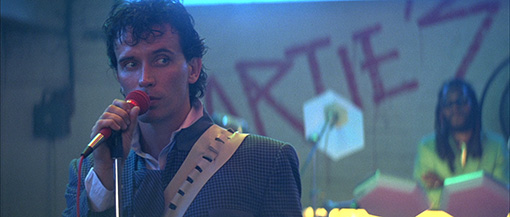
One last thing I will comment on before I hand over to Camus is the film's most famous line, one that my colleague deliberately avoids quoting and the writer and director make a point of not commenting on during their commentary track. I mention it only because in addition to becoming the film's most readily recalled line of dialogue, it's also the most misquoted. The line in question, as delivered in the film (hop to the next paragraph if you don't want to know), is "No matter where you go... there you are." When I watched the film again I had forgotten how much of that line's appeal lies in its delivery, in Weller's gentle intonation, the perfectly judged pause, the slightly raised eyebrow and almost imperceptible nod of assurance. But almost every time I've heard or read that line quoted – including by John Lithgow in one of the extras on this very disc – "No matter where" is compressed into "Wherever". Am I being too petty? Ah, what the hell. We're talking cult movies here, what do you expect? Over to you, Camus.
| |
"Well, actually, an unlikely source was producer David Begelman, who was really our enemy for the entire movie. He was the guy who said, "Go ahead, you can make this movie," but he never got it on any level. And so, when it ended just with a kiss, he said, "it needs something else." And we had no money, at all, at that point. And he said, "I'm going to pop for some sort of choreographed ending that we can talk about." |
| |
Director W.D. Richter on that wonderful end sequence…* |
There's
a certain logic in a studio or wealthy individual investing
in a movie with elements that have delivered the goods
in the past. You couldn't go wrong throwing dollars
at pre-Oscar conscious Spielberg. The two Toms haven't
exactly disappointed. The 'elements' (as they are known
in Hollywood) are the chips most likely to settle themselves
on winning numbers. If Goldman's dictum "nobody
knows anything" can be questioned, it's with hindsight.
People can claim to know something. If Spielberg and
Cruise unite their core fan bases and add to them, whoever
invests is almost bound to make a return (considering
the vast, powerful marketing army behind these elements,
it may be as close to a sure fire thing Hollywood ever
gets). There is logic in all of this. Anything happens
(a movie may make money from simple word of mouth, for
example) that is outside this logic is known as a non-recurring
phenomenon (in other words a fluke the suits cannot
build in to any fiscal projection). No one can apply
science to the movies themselves. They are all by definition
prototypes. Sometimes a movie comes along like some
cosmic accident or planet realignment, a movie you just
can't believe ever got made (and yet you are so
thankful it did).
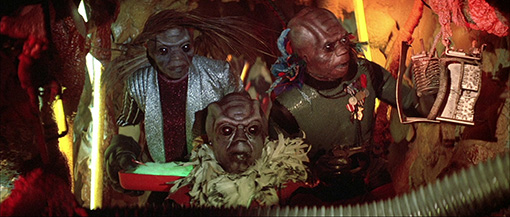
Slarek
once asked how you went about persuading anyone to invest
in, for example, David Cronenberg's Spider (but thank God someone did). Despite elements in place
(Cronenberg himself and actor Ralph Fiennes) and with
all respect, this duo are not as worthy as insurance
against financial under-performance as Spielberg and
Cruise (outsiders breathe sighs of relief). If there
are always Red Rums then we're here to notice what the
miniature Shetlands do. Often they do it better. According
to the director, MGM's David Begelman saw the script
of Buckaroo Banzai and said "this
is something special, go make it..." It gives
me hope that some of 'us' are in with 'them'. That was
written before listening to the commentary. I'll let
it stand for now but read on.
So
what have we here? A movie that was released the year
the Macintosh came out (1984) and it's the oddest, most
idiosyncratic, most surreal, 'Hollywood' movie I think
I've ever seen. A synopsis would take three pages. Even
its title, originally just Buckaroo Banzai,
was changed into something even odder and (one would
think) even more un-commercial. The studios insisted,
according to W.D. Richter's commentary, that those simple
two words would confuse people and actually keep them
away from the cinemas. So they changed it to (I cannot
help but smile) The Adventures of Buckaroo Banzai
Across the 8th Dimension. That ought to have
packed them in except that it didn't. MGM's fancy 2005 DVD and this even more lavish Blu-ray from Arrow means that there is some money somewhere
bet on the miniature Shetland (or rather some hope that
there are enough odd folks out there that would purchase
such an oddity). Based on VHS popularity, I'd say the
number crunchers got it right. I'll have a go at some
sort of sum up. Please note that if the assembled cast
of this movie would now come together for a sequel,
before a frame was shot, the production would be about
$150 million in the hole. There are some very famous
and expensive actors in this piece. Whatever happened
to Ellen Barkin?
Buckaroo
Banzai (Peter Weller) is the head of a group of extraordinary
men. As well, as being a neurosurgeon and a rock star,
Banzai is a scientist who discovers an '8th dimension'
contained in the molecular 'space' in solid objects
after driving through a rock face. Inside this new dimension
live Lectroids (smooth reptilian humanoid aliens originally
from Planet 10). In the 30s, under cover of Orson Welles's
infamous War of the Worlds radio broadcast,
a group of renegade Lectroids headed by John Big Booty
(or Booté) played by Christopher Lloyd, took
over a scientific institute, Yoyodyne, to create a device
to enable them to get off the Earth. Enter the bizarre
but wonderful John Lithgow as a half human, half Lectroid
(Lizardo/Whorfin respectively), all-weirdo who escapes
from his lunatic asylum in truly gleeful fashion. The
way he dispatches the hospital guard while still on
the phone is a highlight as is his going back into his
own memories via some curious makeshift electrical devices.
Lithgow will go as far as any director wishes and strain
to go further. He is never less than gloriously entertaining.
Back to the plot. Good Lectroids (in orbit and all Rastafarian
– why? No one knows! Joy!) enable Buckaroo to recognize
the bad Lectroids. The two teams battle to find the
device that will enable both teams to complete their
opposing mission, the oscillation overthruster.
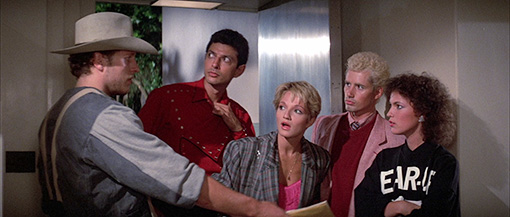
That's
the straightest line I can draw. Woven and spun around
that line are many, many subplots and incidents, some
of them hilarious. Walking through a tense situation,
Jeff Goldblum follows Pepe Serna. Goldblum sees something
incongruous on an experiment table. "Why is there
a water melon there?" he asks. Pepe answers "I'll
tell ya later." Buckaroo is so
full of moments like that, that the plot sometimes uncurls
via those little script nuggets, gems you think are
there because they are funny and tangential. Incidentally,
the watermelon was placed into the set as a directorial
power play. To ascertain that MGM exec (the afore mentioned
David Begelman) was still watching rushes, W.D. Richter
just inserted the watermelon (something which had nothing
to do with anything). If Begelman was still riding the
production, he would have been all over the director
for taking the piss. And yet in the context of Buckaroo's
existence, it makes a sort of perverse sense.
The
production design (ably abetted by prop master Erik
Nelson) is suitably out there in some odd dimension
only known to the art crew. Good, black Lectroids sit
on impossibly high seats in their coral-inspired craft
and when I first caught Buckaroo, that
image stayed in my head for long after the theatrical
run had become a nice memory. Props are funky, funny
and fit the milieu like some lost pieces of a giant
jigsaw that suddenly turn up. My favourite has to be
the "Presidential Emergency Action Documents; Declaration
of War (The Short Form in case of emergency only)."
Priceless.
Weller,
more famous for his Robocop role, plays
Banzai absolutely straight which is just as well. If
he lurched into parody or histrionics, the eight wheeled
bizarro-pic of Buckaroo would tip and
crash onto its side. Richter was smart to keep Weller
on the straight and narrow. He is an engaging and oddly
plausible Buckaroo. The team are all cast well, with
a special nod to tough guy Clancy Brown who's credited
by the director as being the heart and soul of the Hong
Kong Cavaliers. Jeff Goldblum replays his mannerisms
in the guise of a neurosurgeon this time. Make no mistake,
he's entertaining but his Goldblumminess (could that
ever be a word?) has hold of him here big time. He's
indistinguishable from playing James Watson in the BBC's
(or rather director Mick Jackson's) Life Story – renamed The Race for the Double Helix for US consumption. Of all people, Welsh actor Ronald
Lacey plays the President (after a back operation –
or even a rectal one as mooted by 'Reno' on the commentary)
suspended in a wire convalescent device. Lacey is playing
Orson Welles circa 1940 and does a good job except for
the voice which was subsequently overdubbed – another
one of executive producer David Begelman's decisions
(see notes on the Commentary in the Extras, below).
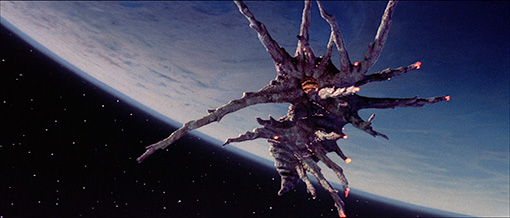
The
effects were not bad at all given the year and the budget.
Ships fly convincingly despite the absence of any computer
technology. At this point in history (pre-Mac), computer
screens are green on black and computer graphics are
thin yellow lines that approximate real objects the
way that Gerald Scarfe's caricatures approximate real
people. The science fiction and comedy elements tend
to overwhelm any sense of menace or real drama but that's
unimportant in Banzai's case. The movie
is a self-confessed oddity, a real space oddity so to
speak with a nod to Mr. Bowie. But it's hugely engaging
and when was the last time you heard a movie torturer
suggest adding more honey? Charming!
Nothing
like movie characters going out in style. Over the end
credits, the stars return (even the dead one), marching
to the very 80s rock drum beat in the L.A. storm drains.
For some reason this mini-sequence is utterly enchanting
(paid for by the exec.) and the only hic-cough is the
brazen announcement of the sequel that never would be.
A pity.
| sound and vision [Slarek] |
|
For years I've dreamed of seeing Buckaroo Banzai looking as good as it does here. Like so many of its fans, I first discovered the film on VHS, cropped to 4:3 and fuzzy on picture detail. The 2002 MGM DVD was thus a revelation, presenting the film in its correct 2.35:1 aspect ratio and with a level of detail we former tape viewers had never before seen. This HD digital transfer was created by Ascent Media in Burbank, California for MGM, with additional picture clean up performed by the fine people at Deluxe restoration in London under Arrow's supervision. And it looks terrific. The film has a bright, almost comic book look that really leaps to life here, especially evident in the vibrant (but never over-saturated) colour and the sublimely pitched contrast. The more stylised lighting of the nightclub sequence – the only scene shot by Blade Runner's Jordan Cronenweth – presents a bigger challenge for digital transfers, but looks gorgeous on this transfer. One unfortunate side effect of quality HD transfers of 70s and 80s genre films is that they sometimes expose the imperfections of the optical effects, and what surprised me here is how terrific they still look, although it's easy to forget that in spite of its quirky indie sensibilities, Buckaroo Banzai was a studio production made seven years after Star Wars set the standard for how such effects should look. As expected, the image is almost completely free of dust and damage and sits rock solid in frame. Wonderful.
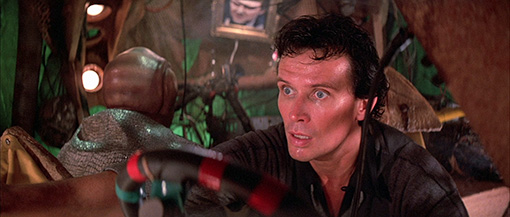
There are two soundtrack options, Linear PCM 2.0 stereo – which I'm guessing is the original mix – and a DTS-HD Master Audio 5.1 surround created at P.O.P Sound by MGM. Both are clear and lively, but the 5.1 really does the film justice, beefing up the bass response (the opening rocket car test is particularly good on this track) and throwing a few key sound effects to the rear of the room, making for a more immersive experience. It also has slightly more finesse on the dialogue than the stereo track, though personally I've no real complaints about either.
Optional SDH Subtitles for the hearing impaired have also been included.
Some of the extra features here have been ported over from the earlier MGM DVD, and the coverage below is a mixture of comments from Camus and Slarek. Do you really care who said what? No, I thought not.
The Tao of Buckaroo (16:36)
A newly shot interview with leading man Peter Weller, who talks about his early days as a music major and his subsequent switch to theatre, and how after Buckaroo Banzai he and Jeff Goldblum formed a jazz trio that grew into a sextet and eventually cell divided to land them a band apiece. Sometimes they still play together even today. His confirms that he chose to play Buckaroo as a combination of Elia Kazan, Jacques Cousteau and Adam Ant, talks about David Begelman's decision to replace director of photography Jordan Cronenweth because it was felt he was working too slowly (Weller assures us "it was a sad day in hell when we lost him"), and expresses bemusement that the critics and marketing people 'got' Naked Lunch but didn't know what to do with Buckaroo Banzai. There's plenty more here, all of it worthwhile.
Lord John (13:39)
In a new interview conducted especially for this release, John Lithgow talks about playing a "deliriously fun bad guy" and reveals how he shaped his wild Italian accent and landed the studio costumer a credit on the film as his dialogue coach. With the exception of his time on TV series Third Rock From the Sun (where he also played an alien in human form), he remembers Buckaroo Banzai as being the most fun he ever had on a film set, and is pleased that the movie finally found the acclaim and following he always felt it deserved.
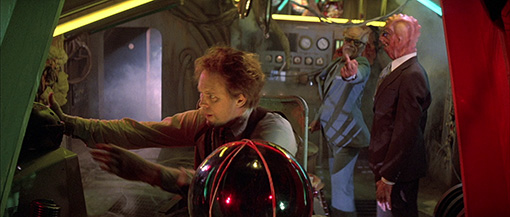
Buckaroo Banzai Declassified (22:50)
A cast and crew background interview snippet show (everyone having a great time) but the most interesting aspect is the longer interview (or presentation) by the director W.D. Richter. He maintains the silly but lovely illusion that Buckaroo Banzai is for real and acts accordingly (props are the real thing etc.) For any other movie this may have come across as tiresome nonsense but here? It's a lot of fun.
Lincoln Center Q&A (43:27)
A Q&A with actors Peter Weller and John Lithgow, hosted by Kevin Smith following a screening of the film as part of Smith's 'Smoviola' series at the 49th New York Film Festival, which kicks off with Smith delivering a passionate and very eloquent appreciation of the film and his discovery of it. Things move up a gear once Weller and Lithgow take the stage, with Lithgow in particular proving a fountain of funny stories, from the truth behind the credit for his dialogue coach to his Paris encounter with the man who dubs his voice on the Italian prints of his films, tales that have Smith and Weller in stitches. Smith asks good questions and the responses are always both revealing and entertaining, and he sums up part of the movie's appeal when he says, "You really figure out who you want to hang out with by watching Buckaroo Banzai." At one point Weller asks an audience member to wake his companion up because his snoring is so loud, which prompts Smith to later observe, "He is now wide awake in the front row... because he got fuckin' bitch-slapped by Robocop." There's loads more here of note. A terrific extra.
Visual essay by Matt Zoller Seitz (18:06)
Becoming a regular feature on Arrow releases are video essays in which aspects of the film are vocally explored by a writer and illustrated by clips from the film in question, plus stills and posters from other referenced works. This one is by Matt Zoller Seitz, editor-in-chief at RogerEbert.com, and it's pretty good, although most of the factual stuff is also covered on the other extra features. Seitz's personal opinions are the most interesting element, and the points about the influence of The Right Stuff on the opening sequence are well made.
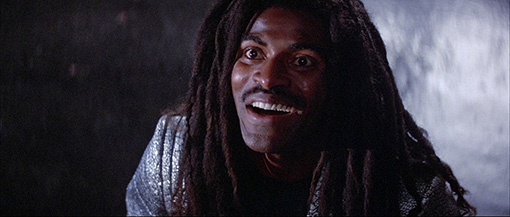
Alternate Opening (7:14)
A home movie sequence that was originally intended to kick off the film, a scene that shows a defining moment in Buckaroo's past. With Jamie Leigh Curtis playing Buckaroo's mother (the actress loved what Richter was doing and wanted in), she and Buckaroo's father are killed when the experimental jet car they are piloting explodes. The title here is the more modest Buckaroo Banzai. You can watch this scene in isolation or in place as the film's opening sequence.
Audio Commentary
The Commentary by director W.D. Richter and (if you heard only the commentary) a member of the real Buckaroo's Team, Reno Nevada, is a scream. Nevada, of course, is the writer Earl Mac Rauch. Buckaroo Banzai created an alternate world that both director and writer (sorry, Reno) acknowledge as real all throughout their commentary. I don't think I've known a disc to maintain that kind of pretence as well as these two. Commentary highlights indicate that the 'factual book' upon which the docu-drama Buckaroo was based was full of stuff not included (something true about the novelisation too according to the user's comments on the IMDb). Apparently Lectroids were at the last supper. The movie's most famous line (I won't repeat it) elicited this comment from the director; "That line needs to be out there…" The best insight to why Buckaroo lived on (on VHS, DVD and now Blu-ray) is the idea that one fantasises about working in and for a team like Banzai's. To get up each morning to join a team you felt you belonged to, to do good work. Isn't that what we all wish for? Slarek need not answer that question. But I believe that that insight has some broad merit. It was definitely the glue that held Buffy together, that sense of team. Richter has a last word on his initial champion and then whip cracking exec David Begelman. In an exchange near the end, Banzai originally says the words "I don't know," in a situation of jeopardy. According to the Movie Execs' Bible, heroes are not indecisive in dangerous moments. Richter adds, dripping with sarcasm: "Don't let any idiosyncratic humanity sneak into this thing, crank it out."
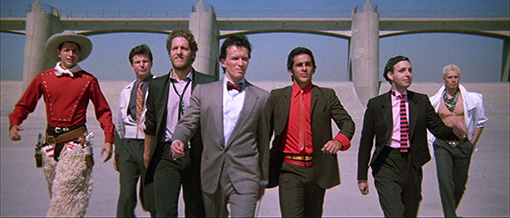
Closing Sequence (4:03)
What is it about this film's closing sequence that has prompted everyone I know who has seen the film to fall in love with it? On paper it doesn't sound anything special (worry not, there are no spoilers here as this is a stand-alone sequence). Dressed in a suit and bow tie, Buckaroo lowers himself down onto the floor of a storm drain where he is joined by the rest of the Hong Kong Cavaliers. As they march forward to the beat of an impossibly catchy electronic tune that will convince you machines can whistle, they are joined by other key characters from the film, their purposeful strides interspersed with the occasional skip. The camera pans with them and comes to rest on the words 'BUCKAROO BANZAI', with the 'I' painted like an upside-down, lower case 'i', which doubles it up as an exclamation mark. And that's it. But for so many of the film's fans, myself included, it's just about the coolest ending to any movie ever. Here it's presented without the closing credits that adorn it in the film proper, and despite the fact that some this sequence also runs under the main menu (meaning that in the course of this review I've seen it a lot), I've still watched this particular extra about thirty times and have repeatedly caught myself walking in the very manner that the members of Team Banzai do here. More than anything else in the film, it makes you want to be part of this group, but to get the full effect it has to be seen first as the film's conclusion. The final character walk at the end of Wes Anderson's The Life Aquatic with Steve Zissou was apparently designed to pay homage to this sequence.
Deleted Scenes (14:15)
Not so much deleted scenes as 14 deleted portions of existing ones. Some are no more than a single shot of only a few seconds in length, while one runs for a weightier three-and-a-half minutes. Most have not been sound mixed so lack background noise and music, and all have edited into the sequences in which they were originally intended to sit. The deleted footage is easy to spot, having been sourced from the original workprint and thus of far lower quality than the surrounding material. All are of interest, particularly the small piece of additional footage of the crying Penny Priddy in the nightclub scene, which changes what Buckaroo is asking the audience not to be mean about.
Theatrical Trailer (1:17)
Predominantly a re-cut of the storm drain ending (including footage not used in the film itself) intercut with some of the more bizarre images of the film. I would have been in line on day one.
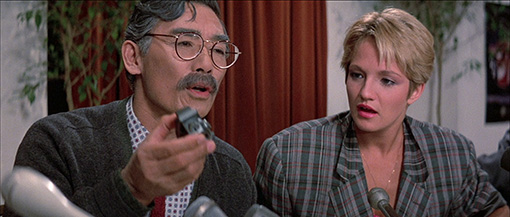
Jet Car Concept (2:26)
A CG rendering of a Banzai Jet Car escaping enemy craft by travelling through an iceberg, and using itself as a rescue craft for a front undercarriageless Space Shuttle.
Gallery
A blend of press stills and altogether more interesting behind-the-scenes shots (the Red Lectroid looking through the Panavision camera viewfinder is a personal favourite), plus a couple of concept drawings.
Banzai Radio (10:02)
Terry Erdman, unit publicist for 20th Century Fox when Buckaroo Banzai was released in 1984, is interviewed by Denise Okuda, a name that should be familiar to fans of Star Trek: The Next Generation. There's some interesting stuff here, in particular how close we came to seeing the proposed second film, funding for which was apparently in place before it all fell through at the last minute.
Booklet
The key inclusion in the 20-page colour booklet you'll find tucked inside the case is a damned good essay by James Oliver that pertinently asks what constitutes a cult movie, a question Oliver proceeds to persuasively answer. His analysis of the film itself is also sharp and avoids obvious crossover with the other extras here. Credits, stills and details of the restoration are also included.
A rare (but not unique by any means) case of a studio film that failed to ignite at the box-office but eventually built a passionate following on home video. Ahead of its time? Maybe, although I'm willing to bet that for a modern mainstream audience, The Adventures of Buckaroo Banzai Across the 8th Dimension feels as out there as it did back in 1984. But this is the stuff from which cult cinema is made, an intelligent risk-taker that refuses to lay everything out for the viewer, hitting the ground running and leaving it to you to catch up and work out what's going on for yourself. And it's fun. Oh man is it fun. Arrow's Blu-ray is the release we probably weren't aware we were all waiting for, sporting a transfer you'll want to hug and a glorious collection of extra features. Highly and unreservedly recommended.
* http://news.moviefone.com/2011/08/15/buckaroo-banzai-anniversary-sequel-trivia-director-interview/
|